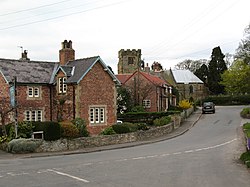Felixkirk
| Felixkirk | |
| Yorkshire North Riding | |
|---|---|
 Village Street, Felixkirk | |
| Location | |
| Grid reference: | SE467847 |
| Location: | 54°15’23"N, 1°16’57"W |
| Data | |
| Population: | 100 |
| Post town: | Thirsk |
| Postcode: | YO7 |
| Local Government | |
| Council: | North Yorkshire |
| Parliamentary constituency: |
Thirsk and Malton |
Felixkirk is a village in the North Riding of Yorkshire. The village is situated about three miles north-east of Thirsk. The population of the civil parish was estimated at 100 in 2014.
The nearest villages are Thirlby a mile to the east; Sutton-under-Whitestonecliffe a mile and a half to the south-east; Upsall a mile and a half to the north; and Boltby two miles to the north-east. Thirsk is almost three miles away, to the south-west.
Contents
History
The village is named after its church, itself dedicated to St Felix, a Burgundian who travelled with St Paulinus converting the English to Christianity during the seventh century. The village may have not been known by its current name at the time of the Norman invasion as it does not appear in this form in the Domesday Book of 1086.
The Domesday Book describes Fridebi with the manor lands shared between Gamal, son of Kalri and Ligulf, subsequently passing after invasion to Hugh, son of Baldric, who made Gerard of Boltby lord of the manor.[1]
There are competing etymologies for Fridebi: it is sometimes taken to mean Peaceful Place from fred, a Danish word for peace.[2] Alternatively, like other hamlets with Danish derived names it might mean Freda's dwelling.[3]
Nearby hill, Mount St John, was the location of a preceptory of the Order of St John of Jerusalem built in the 11th century. After the Dissolution of the Monasteries, the preceptory buildings were handed to the Archbishop of York. In 1720, the buildings were pulled down and a new manor house built. Still known as Mount St John, it is a grade II* listed building.[4]
About the village
A bowl barrow at Howe Hill in the parish is a scheduled ancient monument. There are two Grade II* listed buildings (St Felix church and Mount St John) in the village and five Grade II listed structures.
Church
The village church is dedicated to St Felix and was substantially rebuilt in 1860 by William Hey Dykes, who is responsible for the unusual rounded apse. It is a Grade II* listed building.[5]
| ("Wikimedia Commons" has material about Felixkirk) |
References
- ↑ Felixkirk in the Domesday Book
- ↑ Buckrose, J. E. (1913). Rambles in the North Yorkshire Dales. Mill's & Boon Ltd. p. 127.
- ↑ Johnston, Rev. James B. (1915). The Place-Names of England & Wales. John Murray, Albemarle St, London. p. 259.
- ↑ Bulmer's Topography, History and Directory (Private and Commercial) of North Yorkshire 1890. S&N Publishing. 1890. pp. 699, 700. ISBN 1-86150-299-0.
- ↑ National Heritage List 1241255: Church of St Felix
